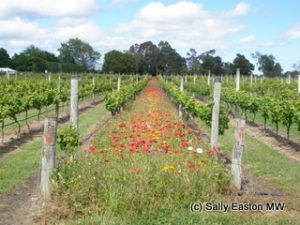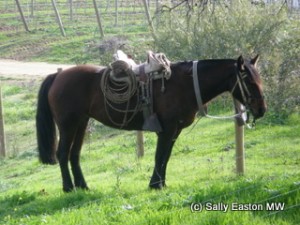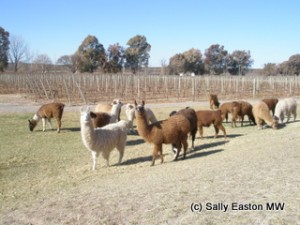Re-discovering biodiversity
A version of this article first appeared in The Drinks Business, January 2010.
Biodiversity is the latest in a series of buzz-words in the field of sustainability as all agriculturally-based industries address the vagaries and pitfalls of mono-culture. It encompasses the an overriding need to reduce industrial chemical inputs which are generally acknowledged to denude the natural ecosystem over time.
One of biodiversity’s challenges is that it is a broad, albeit tangible, church, and as with other buzzwords, it is open to misleading communication. Dr. Linda Thomson, Senior Research Fellow at CESAR (the Centre for Environmental Stress and Adaptation Research) in the University of Melbourne, Australia explained: “biodiversity is a diverse suite of animals and plants present in any ecosystem. It’s important for agriculture, vineyards included.

Inter-row diversity, invertebrate habitat (NZ)
“If we enhance useful biodiversity, we can provide an economic reason for being interested in it: if, for example, it increases the suite of natural enemies.” Her specialty is invertebrates which she said: “underpin everything, and by enhancing the biodiversity of invertebrates, you assist with the whole chain.”
Functional biodiversity
We’re familiar with the concept of functional aspects of biodiversity being harnessed to reduce negative impacts on the environment, for example using parasitic wasps to reduce pest populations, rather than using chemicals.
Alongside such benefits, biodiversity seems to be gaining ground as economic benefits are also highlighted. Dr Maarten van Helden, associate professor at ENITA – Bordeaux University, who specialises in agro-ecology and integrated pest management, believes the economic benefit of biodiversity is an important part of the communication. He said “Farmers see biodiversity as being a functional part of the agro-ecosystem. They would normally perceive it as something that provides a service, for example, reducing pest and insects.”
Van Helden went on: “managing vineyards to be able to conserve biodiversity creates costs on one side, such as planting hedgerows, but other practices, for example mowing can be done less frequently.” However such connections may not always be clear-cut, as Philippe Bardet of Château Val d’Or in St Emilion, whose commitment to biodiversity has been growing for 15 years, said “we have fewer passages through the vineyard in a tractor, but savings are balanced because we need to spend more time on personal inspection in the vineyard.”
The entire 1,500 hectare Saumur-Champigny appellation has recruited van Helden to help with biodiversity. They asked him to create a landscape management plan which would reduce insect pests in the area. Van Helden said: “We looked at pest insects across the whole appellation and showed the main pest insect was grape berry moth (Lobesia); it is the main insect of monoculture and is reduced in non-mono culture.” A growing 25 km of hedgerows is one of the results.

Vineyard worker? (Chile)
Vice president of the producers’ syndicate, Fredrik Filliatreau, for whom this project was his main pre-occupation for six years, during his presidency of the syndicate, said “this is a big step for us. We’re not looking to transform the appellation into organic. The main idea is to make growers think about ecology. A lot of the growers over 50 years old; they have wonderful experience, but may not be very sensitive about ecology. But they are pleased to be involved: it’s good for their wallets because they use less money. And it’s better for the ecology.” The syndicate has funded a full time co-ordinator to develop the biodiversity work in the appellation and wider community.
The idea is clearly gaining pace in France. At the end of 2009 St Emilion launched an appellation-wide biodiversity initiative under the technical aegis of Philippe Bardet. He said it all “starts with respect for biodiversity. You have to think it before you do it. Viticulturalists will not change three generations of practice overnight.” The idea, he said, was “not to introduce rules into St. Emilion, but to understand the interactions between all living things and their viticultural ecosystem.”
Thomson’s work in Australia on the potential economic benefit of shelter belts was positive. She said: “you can buy some animals commercially – lady beetles, some parasitoids, such as trichogramma. These are little insects that lay eggs within the egg of something else. One single trichogramma female will lay her eggs into many moth eggs. We compared the number you get from vegetation to the cost of buying those from a commercial supplier, and found the piece of vegetation is worth thousands of dollars in respect of pest control.”
Community, conservation and collateral benefit
Even with evidence of the economic argument, the biodiversity picture is, well, diverse, and it’s closely linked with what’s outside the plot of vines. The pursuit of biodiversity requires land that is not being used for crop.
But it doesn’t mean abandoning parts of commercial vineyards. Van Helden said “normally viticulture does not occupy all the space. There’s often 5-25% of surface not used to plant vines.” Thomson said “producers [in Australia] are working towards 10% of their land under alternative vegetation,” adding “aiming for 10% is not always a sacrifice: some regions within vineyards are not suitable for vines. And there is concern about chemicals in communities, so vegetation belts may be seen as a protective screen.”
The whole community is being involved in the Saumur-Champigny project, where, Filliatreau said: “It’s not just about vineyards. Our entire zone is 60 square kilometres, and we are only 1,500 ha. We have a full-time person at the syndicat to develop biodiversity with the growers and with the villages.”

Collateral benefit? (Argentina)
The conservation aspect was a driver in South Africa, where the biodiversity and wine initiative (BWI) grew, at least in part, out of a need to conserve the rapidly dwindling Cape Floral Kingdom. It’s one of around 30 biodiversity hotspots in the world, which by definition, has lost more than 70% of its original habitat.
Inge Kotzé, BWI project co-ordinator said: “we have 156 producers accredited by BWI and 118,000 ha now written into long term conservation.” This is more than the entire South African vineyard hectarage. She added: “an equally important achievement of this project is the amount of area cleared and maintained free of invasive alien plant species, estimated at least 50,000 hectares, with long term alien clearing activities underway.” The ‘aliens’ for example, pines and gums, are water-hungry so their removal makes available a greater proportion of water to native vegetation, and lessens the frequency-risk of sporadic fires.
The collateral benefit from greater biodiversity is a theme picked up by Su Birch, CEO of WOSA, an industry organisation which promotes South African wine abroad, who said “there are some species that are more useful than others – baboons are not very useful – but it is about balance. Once the vineyards grow along side natural habitat the input costs are hugely reduced as nature gets things in balance: for example more insects mean more guinea fowl, more guinea fowl means the lynx return, more moles mean the owls return.”
New Zealand, another biodiversity hotspot, also has unique flora to conserve. Philip Manson, science and innovations manager at New Zealand Winegrowers said they are “looking at native species to bring back into the vineyard. You get a double effect of enhancing nature’s systems and retaining native vegetation.”
And Manson highlighted the native NZ falcon as a conservation project-cum-collateral benefit to the wine industry. The NZ falcon is rarer than the kiwi. Falcons have re-colonised the Wairau Plains, in Marlborough, from which they’d been driven by over a 100 years of man’s influence by sheep farming and latterly vineyards. Not only are there now 27 falcons in the plain, which it is hoped will become a interlinking breeding population with other populations in more remote locations, but Manson said, there’s “evidence that where the birds are based, the damage to grapes is significantly lower.” Bird damage, especially at harvest, costs the NZ wine industry around NZ$70m annually.
Though industry is at a foetal stage of understanding the functional and collateral benefits of biodiversity, the goal must be for more stable, diverse, agricultural systems. Bardet said “if you’ve got balanced biodiversity in an agro-system, over time it is more stable. So when an accident or disease happens, the system regenerates more quickly than if it’s just vines.”



